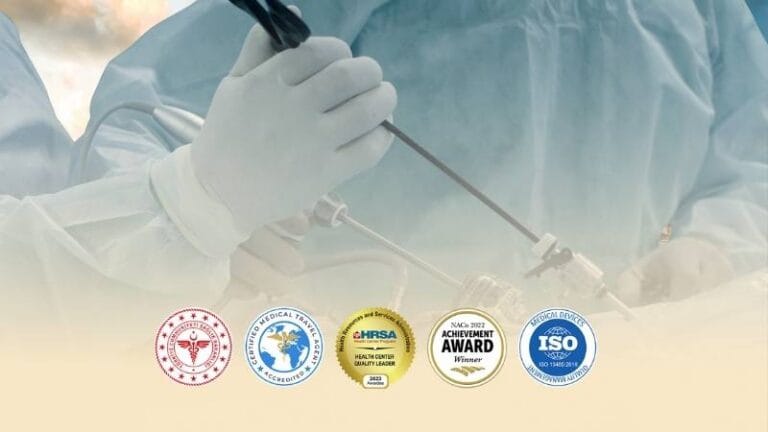Opting for Robotic bariatric surgery in Turkey represents the pinnacle of medical technology for patients seeking the safest possible outcome for their weight loss journey. Turkey has established itself as a global hub for high-tech medical tourism, equipping its leading hospitals with the advanced da Vinci Xi systems to handle even the most complex metabolic procedures with unparalleled precision.
The da Vinci Difference: 3D Vision and Control
To understand the value of this technology, one must distinguish it from standard laparoscopic surgery. In robotic surgery, the surgeon does not stand over the patient; instead, they sit at a specialized console nearby, controlling the robotic arms with master controllers.
This system provides two critical advantages. First, it offers Stereoscopic 3D High-Definition Vision, restoring the depth perception that is lost in standard 2D laparoscopy. Second, the EndoWrist® instruments bend and rotate far beyond the capabilities of the human hand (7 degrees of freedom). Crucially, the system features Tremor Filtration, meaning it filters out even the slightest natural hand shaking of the surgeon, translating their movements into absolute steadiness inside the patient.
Clinic Care Center: Expert Warning
We must be transparent about the necessity of robotics. For a standard primary gastric sleeve on a patient with BMI 35-40, robotic surgery offers little advantage over standard laparoscopy, but costs significantly more. The true value of the robot shines in Super Obese patients (BMI > 50) and Revision Surgeries. In these cases, the thick abdominal wall or internal scar tissue makes standard surgery difficult. The robot provides the vision and strength needed for safety in these complex scenarios.
Standard Laparoscopy vs. Robotic Bariatric Surgery
Understanding the technical differences helps justify the investment for the right candidate.
| Feature | Standard Laparoscopy | Robotic Surgery (da Vinci) |
|---|---|---|
| Surgeon’s View | 2D Monitor (Flat image). | 3D High-Definition. Depth perception is restored. |
| Instrument Movement | Rigid sticks (Up/Down/Rotate). | EndoWrist. Full range of motion (360 degrees). |
| Best For | Standard BMI, Primary Surgeries. | Super Obesity, Revisions, Complex Anatomy. |
| Cost | Affordable/Standard. | Higher (Consumables are expensive). |
| Incision Size | Small (Keyhole). | Small (Keyhole) – similar size. |
Who Needs the Robot?
While the robot is a magnificent tool, we recommend it specifically for patients where it decreases risk significantly:
- Super/Mega Obesity: When the abdominal wall is extremely thick, manual torque on laparoscopic instruments is difficult and physically exhausting for the surgeon. The robot creates a fulcrum effect, reducing trauma to the abdominal wall and allowing precise suturing even in deep tissue.
- Revisions: Patients converting from a Sleeve to a Bypass, or a Band to a Bypass, often have internal adhesions (scar tissue). The robot’s superior vision and dexterity allow the surgeon to navigate and dissect this scar tissue safely without damaging surrounding organs.
Frequently Asked Questions about Robotic Surgery
Does the robot operate by itself?
No. The robot has zero autonomy. It is a slave to the surgeon’s hands. The surgeon is 100% in control at every second; the robot simply refines their movements.
Is the recovery faster?
Patients often report slightly less post-operative pain and a quicker return to daily activities. This is attributed to the robot’s ability to operate with less torque (pressure) on the incision sites (ports).
How much more does it cost?
Robotic surgery typically costs €1,000 – €1,500 extra compared to standard laparoscopy. This fee covers the expensive disposable instruments used by the da Vinci system.
Are the scars smaller?
The incisions are comparable to standard laparoscopy (usually 8mm to 12mm). The benefit is not in the size of the scar, but in the precision of the internal work.
Is it safer?
In complex cases (high BMI or revisions), studies suggest a lower rate of leaks and complications due to the superior ability to suture tightly and accurately.
Can I have robotic surgery for a simple sleeve?
Yes, you can choose it for any bariatric procedure if you prefer the technology, but the cost-benefit ratio is debatable for straightforward cases.
Technology Meets Expertise.
When dealing with complex weight loss journeys, precision is everything. At Clinic Care Center, our surgeons are certified console diplomates for the da Vinci system. Contact us today to discuss if your BMI or surgical history makes you an ideal candidate for Robotic Surgery.
Also Read:
Gastric Sleeve in Turkey
Gastric Bypass in Istanbul Turkey
Gastric Balloon in Istanbul, Turkey

